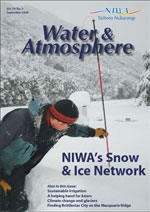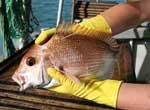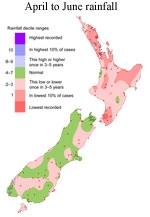Habitat suitability is a familiar concept to most people who collect fish, plants, or aquatic insects from rivers.
PDF of this article (295 KB)



Habitat suitability curves for redfin bully. A suitability index of 1 indicates ideal habitat; an index of 0 is unsuitable habitat.

Ian Jowett and Jody Richardson have used many thousands of observations to chart which habitats suit which fish species.
Habitat suitability is a familiar concept to most people who collect fish, plants, or aquatic insects from rivers. Authoritative publications on aquatic organisms often include qualitative descriptions of the physical conditions in which the organisms are likely to be found. Usually they describe the physical habitat: water velocity and depth, substrate (material on the bottom), and perhaps instream cover (for example, undercut banks, boulders, large woody debris).
The quality of the different habitats in a stream is definedby the relative abundance of animals in them. Usually, animals will be abundant where the habitat quality is best, present in low numbers where the habitat is poor, and absent from unsuitable habitat.
Habitat suitability criteria are important because they are used with hydraulic models to determine the effects of flow changes on fish in streams and rivers and to set minimum flow requirements, usually aimed at sustaining existing fish populations. This is the sort of analysis that informs decisions on water abstraction and allocation.
Staff at NIWA and the Department of Conservation (DOC) have surveyed habitat use by fish in New Zealand streams and rivers over the past 15 years, and have built up a large database of observations. We now have measurements of habitat use for over 21 000 individual fish. The data were obtained mainly from daytime single-pass electric-fishing surveys in wadeable rivers and streams. For some species, such as banded and giant kōkopu, these data have been replaced or supplemented by night-and-day observations from the bank and by netting.
In total, we’ve measured fish and habitat in 5104 different locations in 123 streams and rivers.
Who lives where?
Eels were the most widespread species, found in about half of the rivers surveyed. Upland and bluegill bully were the most abundant widespread species, followed by eels, brown trout, and common bully, all with more than 1200 individuals being caught. We left three fish out of the study – giant bully, black flounder, and shortjaw kōkopu – because we caught fewer than five of each of these species.
While many fish undoubtedly make use of habitat on a micro scale, most habitat suitability observations describe mesohabitats – the characteristics of the area in which the organism lives – rather than the microhydraulics of its precise location. Our data show that, generally, different fish favour different mesohabitats:
- rapid/riffle – torrentfish, bluegill bullies, kōaro, alpine galaxias, and upland longjaw galaxias
- run – juvenile eels, trout, and some galaxiid and bully species
- pool – adult eels, lamprey, various juvenile galaxiid species, and adult kōkopu.
The designations of rapid, riffle, run,and pool habitat do not necessarily mean that those fish are likely to be found entirely in those particular habitats. The margins of riffles often contain slow-flowing water, and many fish species that use run habitat actually live along the margins of riffles.
| Fish species | Total number caught | Average depth (m) | Average velocity (m/s) | Averagesubstrate size (mm) |
|---|---|---|---|---|
| Alpine galaxias | 29 | 0.12 | 0.51 | 64 |
| Banded kōkopu (adult) | 204 | 0.18 | 0.03 | 49 |
| Banded kōkopu (juvenile) | 87 | 0.15 | 0.04 | 58 |
| Bluegill bully | 3253 | 0.24 | 0.68 | 51 |
| Brown trout | 1777 | 0.2 | 0.48 | 68 |
| Canterbury galaxias | 575 | 0.17 | 0.37 | 65 |
| Chinook salmon | 97 | 0.21 | 0.48 | 48 |
| Common bully | 1224 | 0.21 | 0.35 | 45 |
| Crans bully | 560 | 0.19 | 0.18 | 49 |
| Dwarf galaxias | 159 | 0.12 | 0.43 | 52 |
| Flathead galaxias(<50 mm) | 41 | 0.18 | 0.06 | 175 |
| Flathead galaxias(>50 mm) | 160 | 0.13 | 0.41 | 225 |
| Giant kōkopu | 39 | 0.53 | 0.05 | 24 |
| Inanga | 595 | 0.3 | 0.05 | 60 |
| Kōaro | 286 | 0.2 | 0.64 | 81 |
| Lamprey | 24 | 0.27 | 0.1 | 35 |
| Longfin eel (<300 mm) | 1625 | 0.21 | 0.4 | 82 |
| Longfin eel (>300 mm) | 389 | 0.42 | 0.14 | 127 |
| Lowland longjaw galaxias(<50 mm) | 80 | 0.21 | 0.06 | 14 |
| Lowland longjaw galaxias(>50 mm) | 109 | 0.11 | 0.31 | 84 |
| Rainbow trout | 252 | 0.21 | 0.53 | 53 |
| Redfin bully | 564 | 0.21 | 0.25 | 87 |
| Roundhead galaxias(<50 mm) | 2405 | 0.26 | 0.03 | 20 |
| Roundhead galaxias(>50 mm) | 358 | 0.11 | 0.17 | 158 |
| Shortfin eel (<300 mm) | 2137 | 0.22 | 0.28 | 69 |
| Shortfin eel (>300 mm) | 181 | 0.38 | 0.11 | 90 |
| Smelt | 107 | 0.39 | 0.25 | 40 |
| Torrentfish | 784 | 0.24 | 0.72 | 56 |
| Upland bully | 3688 | 0.19 | 0.4 | 51 |
| Upland longjaw galaxias | 8 | 0.14 | 0.51 | 38 |
Thirty fish species: numbers caught and average physical habitat characteristics where they were found.
Charting the curve
To describe the relationship between fish species and habitat, fisheries biologists use ‘habitat suitability curves’. This is a way of graphing the likelihood of a particular species being found in a particular habitat.
We developed habitat suitability curves for 10 new fish species or life stages and revised existing curves for 20 species or life stages. We used a consistent set of procedures that examined habitat use and preference in a number of different ways. These included simply plotting fish density with depth and velocity to see where fish were most abundant. We also developed models that could be used to predict fish occurrence and checked the model predictions against our data on fish presence.
We found that the curves for each species were similar from river to river. The only exception was the landlocked kōaro population in tributaries of Lake Chalice, where the kōaro tended to be in small pools rather than the tumbling torrents that are usually described as their habitat.
Catching a fish at home
- Data on more than 21 000 fish have been collected from over 5000 locations throughout New Zealand.
- By comparing fish presence with the physical characteristics of the locations, we have graphed ‘habitat suitability curves’.
- Understanding the habitat requirements of each species can inform decisions about water management.
Useful link
Learn more about fish and their habits with the NIWA Atlas of New Zealand Freshwater Fishes: niwa.co.nz/rc/freshwater/fishatlas
Ian Jowett and Jody Richardson are freshwater fisheries specialists who both recently retired from NIWA.
A comprehensive description of habitat use and habitat suitability curves for common New Zealand fish species will be published as a report in the NIWA Science & Technology Series.
Teachers’ resource for NCEA Achievement Standards or Unit Standards: Biology Level 2 AS90460, AS90461, US8929, US8930,
